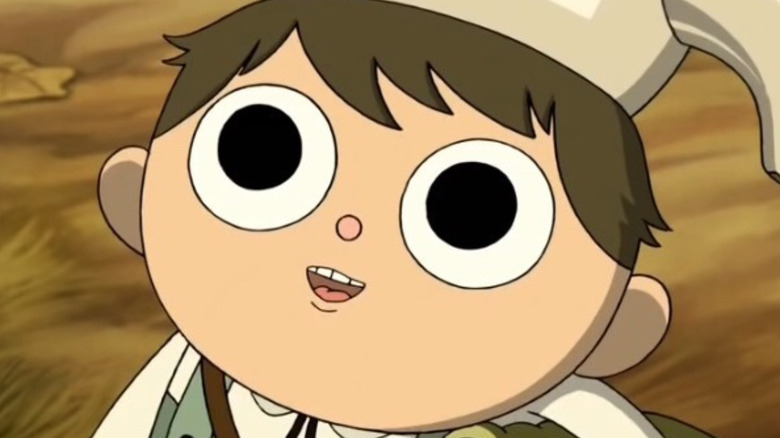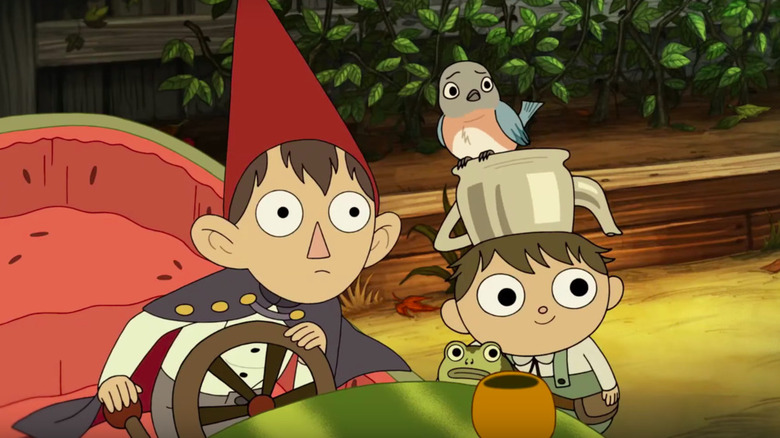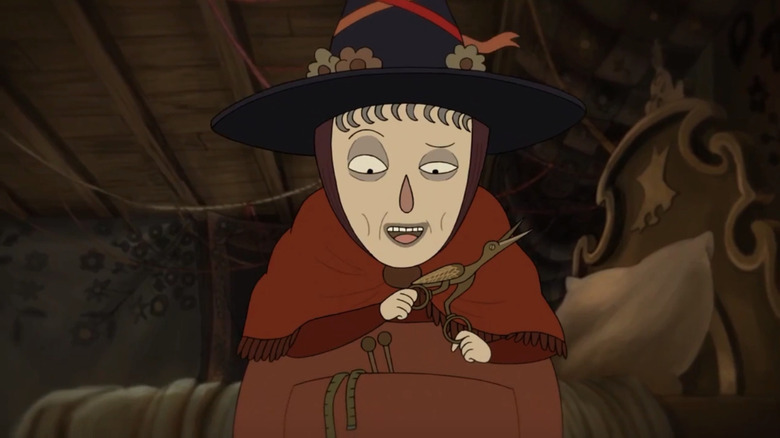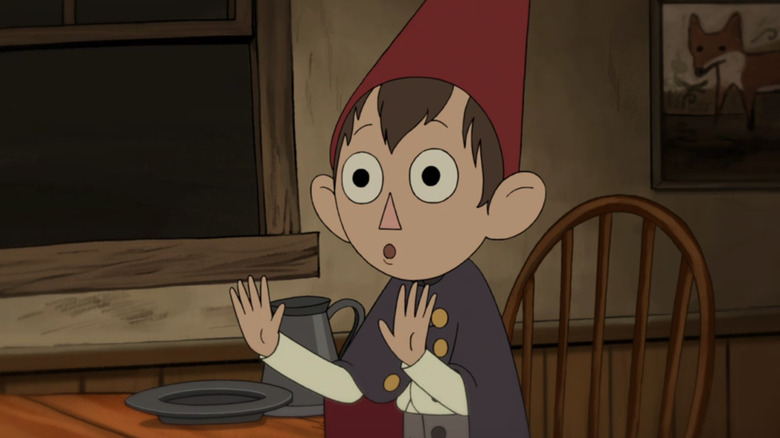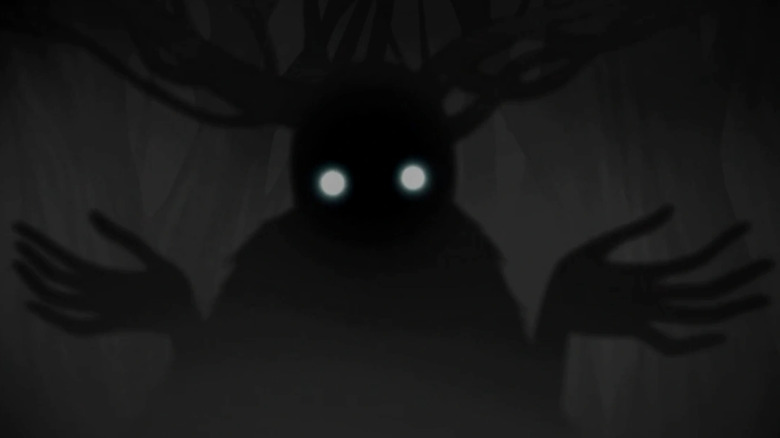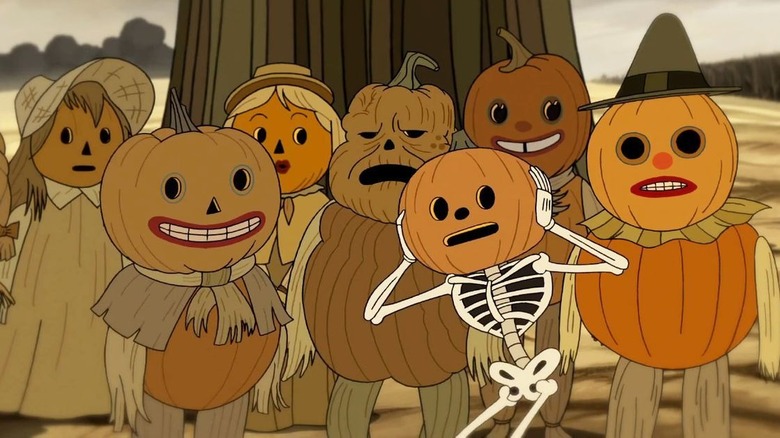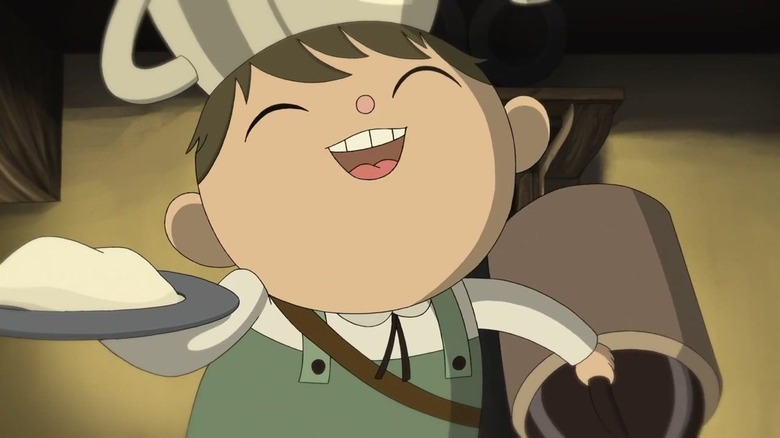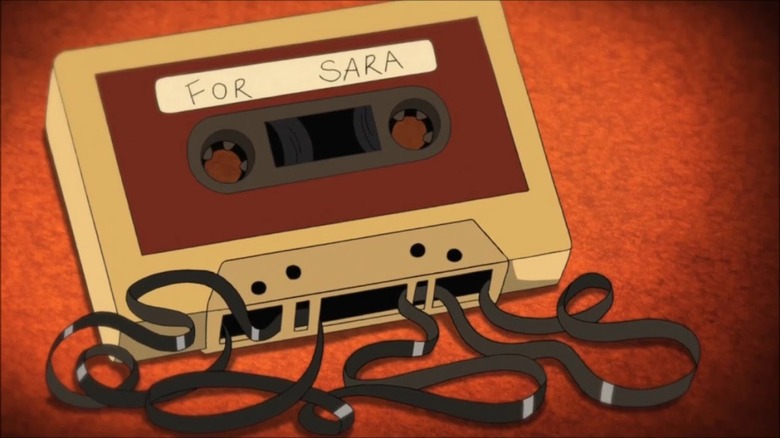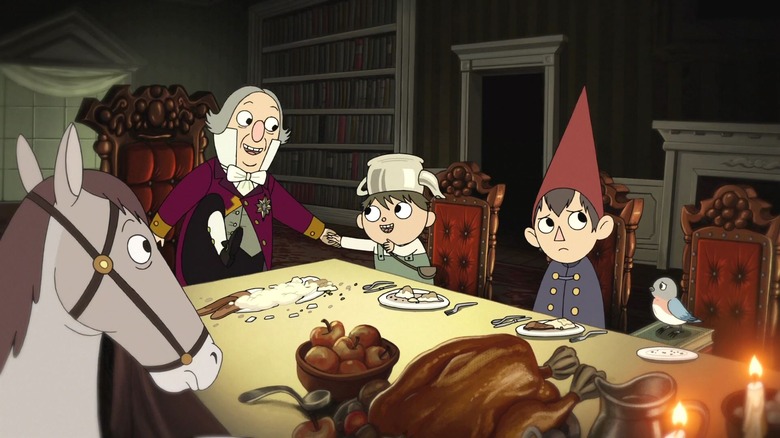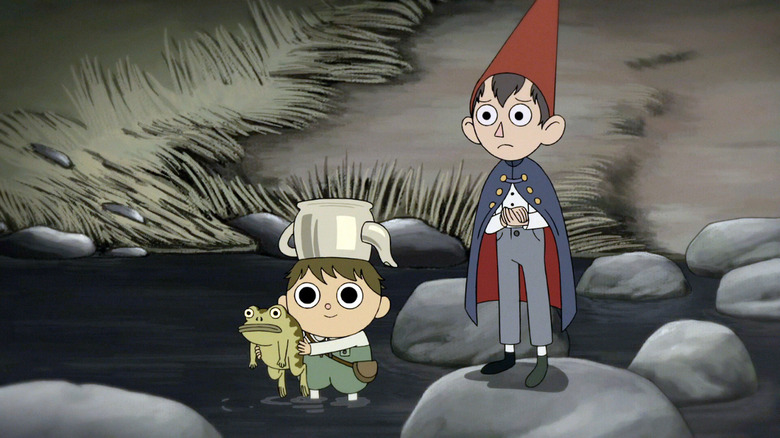Over The Garden Wall Facts Only Huge Fans Will Know
What started as a Cartoon Network Studio short became Cartoon Network's first miniseries. "Over the Garden Wall" has since turned into a modern-day autumn classic. The 10-episode miniseries created by Patrick McHale follows two brothers — Wirt and Greg — as they try to find their way home out of the Unknown while avoiding the wrath of the Beast. Along the way, they meet a mysterious Woodsman and a bluebird named Beatrice, as well as a variety of friendly and not-so-friendly characters.
"Over the Garden Wall" has become an autumn tradition for many, while others are oblivious to its existence. Its obscure cult classic status can be attributed to its initial release, which took place over the span of five days in 2014, from November 3 to 7. The run time of each episode clocks in at only 11 minutes, bringing the entire viewing experience in under two hours. Although it went on to receive critical acclaim, its television broadcast felt like a blip, leaving the show under-appreciated and unknown by many. Thanks to the age of streaming, all that has changed as more and more discovered what they originally missed out on. Still, only the biggest of fans know the facts surrounding the series. Wander into the unknown as we unpack "Over the Garden Wall" facts only huge fans will know.
Began as an original animated short
Before "Over the Garden Wall" there was "Tome of the Unknown," an idea for a series Patrick McHale pitched to Cartoon Network in 2006. Freshly graduated from the California Institute of the Arts, McHale was asked to develop his idea into a feature-length film for the upcoming Cartoon Network feature film department (via Nerdist). Neither the feature nor the department would come to fruition. McHale explains his reasoning for shelving the project on page 13 of the book "The Art of Over the Garden Wall," saying, "The way the story was structured earlier ... to make that into a movie just didn't fit."
Instead, McHale focused on shows like "The Marvelous Misadventures of Flapjack" and "Adventure Time." After moving to New York in 2010, Cartoon Network reached out again asking for a pitch (via Nerdist). McHale reworked his original concept for "Tome of the Unknown" and created a pilot. The short made the festival rounds, including the LA Shorts Fest, the Ottawa International Animation Festival, and the 20th anniversary of the Austin Film Festival, among others, winning numerous awards. The short also won two Outstanding Individual Achievement In Animation Emmy Awards for background painter Nick Cross and background layout designer Chris Tsirgiotis.
With some more minor changes, one of the biggest ones being the name, "Tome of the Unknown" inspired the "Over the Garden Wall" miniseries we know and love today.
The A-list voices behind the characters
By nature, faces are more identifiable than voices, which might explain why voice actors rarely get as much recognition as onscreen actors. You might be surprised to know many of the voices in "Over the Garden Wall" belong to some of Hollywood's biggest A-list actors. Frodo Baggins himself from "The Lord of the Rings" film franchise journeys from Middle-earth into the Unknown with Elijah Wood voicing Wirt. "When we did our first casting call for Wirt, we mostly just got Woody Allen impressions ... I'd imagined him having more of an Elijah Wood type voice, and [Linda Lamontagne] said, 'Well then let's just ask Elijah!' So we did, and he said OK! Kind of amazing," McHale explained to Inverse. In an interview on Late Night with Seth Meyers, Wood recalled how the artwork drew him in, saying, "It was this idea of taking something from the old world and bringing it into people's living rooms now."
Other notable names include Melanie Lynskey as Beatrice, Christopher Lloyd as the Woodsman, John Cleese as Quincy Endicott, Tim Curry as Auntie Whispers, and Fred Stoller as Fred the Horse, as well as Jack Jones, Chris Isaak, and C. W. Stoneking, three musicians who also did vocal work on the soundtrack. When describing Chris Isaak's audition to The Dot and Line, McHale said, "His voice sounded so soothing. But it also reminded me of Sterling Holloway in a way, where the soothing quality could also be used for something a little creepy ... So when the series got picked up, I included the character Enoch just for him." We also get introduced to the great talents of Collin Dean as the lovable comedic relief Greg.
How Breaking Bad and old postcards inspired the show
Inspiration can strike at any moment, and for McHale, that couldn't be more true. From old postcards to "Breaking Bad" to children's books of the 1800s, ideas were pulled from every which way to create the show's one-of-a-kind warm fairytale old Americana feeling. In an interview with Craig Kringle from Weird Christmas, McHale cited the book "The Complete Optimist" by Childe Harold as one of his first visual inspirations for the show. In that same interview, he noted that one of the biggest design similarities to old postcards was the design for Adelaide. "I've always enjoyed going to antique shops, and postcards were something affordable that I could flip through and actually purchase even when I was younger," he explained. "There's something about chromolithography that draws me in. I think it's because, like wax cylinder recordings, you can feel that they're not just reproductions of art... they're actual recorded art."
According to The Los Angeles Times, McHale has also cited Walt Disney's "Alice Comedies" as one of his inspirations, with "Chapter 8: Babes in the Wood" having noticeable parallels to 1923's "Alice's Wonderland" — the first short in the series. But where does "Breaking Bad" come in? According to Inverse, while writing "Over the Garden Wall" McHale was immersed in the final season of "Breaking Bad." As he picked up on the show's organic writing, it inspired him to rely more on his instincts rather than a strict structure: "Once I realized that we could write whatever we wanted, that we didn't have to stay chained to a specific set of tracks, the story began to bloom."
Lost episode ideas
According to page 67 of "The Art of Over the Garden Wall," the decision for the number of episodes was left up to McHale, who originally envisioned 18 chapters. However, due to budget, time, and scheduling constraints — in addition to 18 just being an awkward number — he chose to cut it down to 10. "We didn't outline all those stories, and many of them ended up being folded together or changed, and included in other forms in the series (or the comics)," McHale told Inverse. Some of these lost episodes included "tales of skinless witches and a villain who carves dice from kidnapped children's bones," according to "The Art of Over the Garden Wall." We also missed out on a hunter character, a toad and a snail, and Greg's frog's backstory. One of the biggest cuts involved a multi-episode arc involving Wirt and Greg turning into animals, which can be found in the "Tome of the Unknown" pitch bible where Greg turns into a duck, and Wirt resembles something of a bear or dog. Surely everyone would've loved to see these episodes come to life, but we'll take what we can get.
Story changes
From the initial idea to the final product, it's only natural for things to change — and hopefully for the better. In this case, that process started with the original name, "Tome of the Uknown." In one of the first versions of the pitch, which can be found in "The Art of Over the Garden Wall," the synopsis consisted of the Woodsman introducing Wirt and Greg to a book titled "Tome of the Unknown." It's up to Wirt and Greg to live out the stories contained in the tome or be trapped in the Unknown forever. When the book was dropped from the story, the title was changed to "Over the Garden Wall." "The idea was to make it more like a story quilt," McHale explains on page 83, "with each episode being a different square of the quilt. Each episode was meant to feel very different from the others, but as a group they had to hang together as one cohesive thing." There was also a major change to the overall tone of the show according to the original pitch bible. A big fan of horror and everything spooky, McHale had to tone down the eeriness for Cartoon Network, which was achieved by balancing spookier episodes with more lighthearted ones in between.
Character changes
Characters like the Woodsman and Beatrice remained from the original pitch — with a slight change to Beatrice from bee form to bluebird to better fit the autumnal mood, according to page 25 of "The Art of Over the Garden Wall." One character who experienced the most changes was the show's antagonist, the Beast. What was originally envisioned as a version of the devil named Old Scratch turned into the more ominous, primal version of the Beast we know from the show. On page 13, McHale also explains how this change appeased any corporate parties concerned about including a variation of the Judeo-Christian devil in a kids' show. There was also the change of Wirt's name from Walter (page 13) and updating his nose from a circle to a triangle to make him appear older (page 18). Greg originally sported a sailor's getup, but it was changed to a tea kettle to avoid too much likeness to Flapjack from "The Marvelous Misadventures of Flapjack" (page 20). Then there's Jason Funderberker, whose design took after this photo of McHale. These character changes — both big and small — are all necessary pieces of the same puzzle.
Six new songs were released on the show's sixth anniversary
Music is a major player in "Over the Garden Wall," contributing to the overall mood of the show. The famous soundtrack was composed by the band the Blasting Company, consisting of Josh Kaufman, Justin Rubenstein, and Brandon Armstrong at the time, but there was a great deal of collaboration with musicians like Jack Jones, Samual Ramey, Chris Issak, Janet Klien, while others were recruited for cameo characters with featured songs. "For many songs, artists and friends offered melodies that the Blasting Company helped shape and build. 'Potatoes and Molasses' was written by David Stevenson, an acquaintance of Jim Campbell. Pendleton Ward wrote an out-line of 'The Highwayman,' while Mark Bodnar both wrote and sang 'The Old North Wind' from 'Babes in the Wood,' his voice slowed to a bass in postproduction," McHale offers on page 173 of "The Art of Over the Garden Wall."
What many don't know about the soundtrack is that the Blasting Company released six new songs on the show's sixth anniversary (via Polygon): "When Me and My Brother Had a Row," "Accordion Lullaby," "The Tithing Man," "Sketch of the Unknown," "The Blacksmith's Song," and "Wirt's Clarinets." The company Mondo has also released a limited edition vinyl record of the 32-track soundtrack.
Real-life For Sara cassette tape
In addition to the vinyl record, Mondo also released a limited edition cassette titled "For Sara," a replica of the tape featured in "Chapter 9: Into the Unknown." In this episode, Wirt curates a mixtape featuring poetry and the clarinet — two of Wirt's favorite things — for his crush Sara. But when the tape ends up in Sara's possession, Wirt will do whatever it takes for her not to hear his embarrassing confessions of love. The episode never reveals the actual recordings on the tape, but all that changed with the release of Mondo's version, which features more than 20 minutes of never-before-heard material, produced and performed by the Blasting Company and featuring the voices of Elijah Wood and Collin Dean. The track list contains the following: "Intro," "Far Away," "Chopin Nocturne I," "Translucent," "Chopin Prelude—Opus 28," "Me Frozen," "Two Shoes Blues," "Clarinet Lullaby," "Wakefulness," "If I Were...," "Chopin Nocturne II," "Two Cliffs," "Clarinet Opus 6," and "Outro."
It might be difficult to get your hands on the tape if you missed the initial release, but if you're interested, a recording has been uploaded to YouTube.
Historical references tied to the show
Historical references are riddled throughout the show, which helps give it its signature look. This includes clothing, hairstyles, and other Easter eggs that have been confirmed by McHale and others who have worked on the show. The range of historical references spans from the 1700s to the early 1900s. According to page 11 of "The Art of Over the Garden Wall," after a visit to Concord, Massachusetts, the town's rich history stuck with McHale and found its way into the show. Colonial farms and architecture, candlelit taverns, and golden meadows are all cited as visual representations of the show's New England-esque setting.
As for the costumes, both Wirt and Greg are dressed for Halloween in slightly more modern clothing. Wirt's vaguely historical cape resembles something from a Civil War Union uniform. Then there's Beatrice, who in her human form wears a hairdo and a high-waisted empire dress reminiscent of the Regency era. The Woodsman sports a 1700s hairstyle and 1800s clothing — top hat and all. Miss Langtree from the episode "Chapter 3: Schooltown Follies" was inspired by 1800s paintings of women reading, although her pompadour hairstyle and long skirt paired with a high neck button-up lean more toward the early 1900s. In the episode "Chapter 5: Mad Love," we meet Quincy Endicott, who lives in a Thomas Jefferson's Monticello-inspired mansion. Nick Cross, the show's art director, has written about the inspiration for Quincy on his Tumblr, explaining, "He's basically a cross between George Washington and King George III, my subtle historical nerd joke." Even Wirt comments on Quincy's Georgian-era style. The combination of all these periods makes for a world that's both familiar and fantastical.
Post-show graphic novels expand on the world of the Unknown
Want more of "Over the Garden Wall"? The adventures in the world of the Unknown continue in a series of post-show graphic novels created by McHale and storyboard artist Jim Campbell. The first comic, "Over the Garden Wall Special #1," was released on November 5, 2014, as a standalone featuring an unused episode idea involving Wirt, Greg, and Beatrice stumbling upon a gang of wayward soldiers. In his interview with Nerdist, McHale explained the story fits between Episodes 2 and 3. "Honestly I don't have much of an approach to writing comics yet," he said. "I just took a stab in the dark and stumbled my way through. I think it was Jim Campbell who really pulled it all together. He did the artwork and it's gorgeous. He made it work."
The stories continued in a four-part miniseries. Issue One follows Wirt and Greg as they come across two girls playing, and they're forced to keep them entertained, so they don't wake their giant of a father. Issue Two features the tale of Fred the Horse. In Issue Three, Greg and Wirt follow a band of musical forest animals parading around the woods. Issue Four is a prequel revealing the story behind the disappearance of the Woodman's daughter. After the miniseries, publisher BOOM! Studios announced an ongoing "Over the Garden Wall" series put together by Campbell, show writer Amalia Levari, George Mager, Kiernan Sjursen-Lien, and Danielle Burgos, and drawn by Campbell, Cara McGee, Mager, and Sjursen-Lien. The ongoing comics continue to tell tales that take place in the Unknown.
